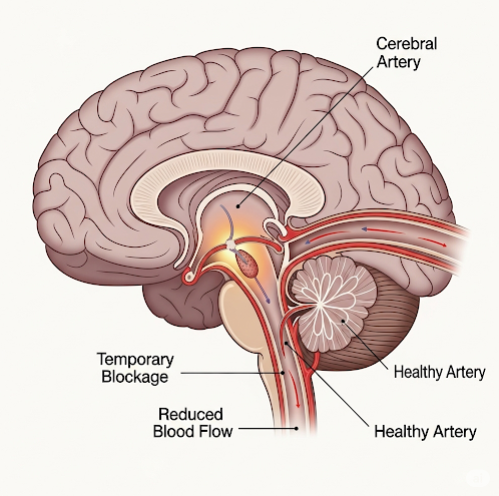Overview
A Transient Ischaemic Attack (TIA), often called a mini-stroke, is a temporary interruption of blood flow to the brain that produces stroke-like symptoms lasting only a few minutes to hours. While TIAs do not usually cause permanent brain damage, they are a critical warning sign of a possible future stroke. In South Korea, advanced stroke centers and neurologists emphasize rapid evaluation, preventive strategies, and early interventions to reduce the risk of a major stroke. Prompt recognition and treatment of TIA are vital for minimizing long-term neurological complications and improving patient outcomes.
What is a Transient Ischaemic Attack?
A TIA occurs when blood flow to part of the brain is temporarily blocked or reduced, often due to a small blood clot or arterial narrowing. Unlike a full stroke, the symptoms are transient and typically resolve within 24 hours, though most last less than an hour. TIAs indicate underlying vascular disease and serve as an early warning system for stroke. Korean medical centers utilize advanced imaging, such as MRI and CT angiography, to assess cerebral circulation and identify high-risk patients for preventive care.
Symptoms
Symptoms of a TIA are sudden and can vary depending on the area of the brain affected. Common manifestations include:
- Sudden numbness or weakness in the face, arm, or leg, typically on one side
- Difficulty speaking or understanding speech
- Sudden vision changes in one or both eyes
- Dizziness, loss of balance, or coordination problems
- Severe headache with no known cause
- Confusion or difficulty concentrating
- Facial drooping or asymmetric smile
Because symptoms are temporary, they can easily be overlooked. Korean neurologists emphasize that even short episodes require urgent evaluation to prevent a future stroke.
Causes
TIAs are usually caused by reduced blood flow to the brain. Common causes include:
- Atherosclerosis: Plaque buildup in the arteries leading to the brain
- Blood clots: Often originating from the heart in conditions such as atrial fibrillation
- Carotid artery disease: Narrowing or blockage of the main arteries supplying the brain
- Small vessel disease: Affecting tiny blood vessels in the brain
- Heart conditions: Heart valve disease or recent heart attack increasing clot risk
- Other risk factors: High blood pressure, high cholesterol, diabetes, smoking, and obesity
In Korea, patients at risk are often evaluated with Doppler ultrasound, echocardiography, and advanced vascular imaging.
Risk Factors
Several factors increase the likelihood of experiencing a TIA:
- Age, especially over 55 years
- Hypertension or poorly controlled high blood pressure
- Diabetes mellitus
- Smoking or tobacco use
- High cholesterol levels
- Heart disease, particularly atrial fibrillation
- Family history of stroke or vascular disease
- Sedentary lifestyle and obesity
Korean public health programs emphasize lifestyle modification, early detection, and routine screening for these risk factors.
Complications
While TIAs themselves do not cause permanent damage, they can lead to serious complications if untreated:
- Increased risk of a full ischemic stroke, often within days to months
- Cognitive decline or memory impairment over time
- Difficulty performing daily activities if recurrent episodes occur
- Emotional impact, including anxiety and fear of future strokes
- Potential cardiovascular complications due to shared risk factors
South Korean hospitals stress that TIAs are a critical warning signal and require comprehensive risk assessment and management.
Prevention
Preventive strategies aim to reduce the risk of TIAs and subsequent strokes:
- Lifestyle modifications: Healthy diet, regular exercise, and weight management
- Blood pressure control: Regular monitoring and adherence to antihypertensive medications
- Blood sugar management: Especially for diabetic patients
- Cholesterol management: Through diet, medications, and regular testing
- Smoking cessation and limiting alcohol: Reducing vascular stress
- Anticoagulant or antiplatelet therapy: For patients with atrial fibrillation or high clot risk
- Regular medical check-ups: Screening for carotid artery disease or heart conditions
Public health initiatives in South Korea educate high-risk populations on early detection and stroke prevention strategies.
Treatment Options in Korea
Treatment of TIA in Korea focuses on immediate evaluation, risk reduction, and prevention of future strokes:
Diagnosis:
- Rapid neurological assessment and symptom documentation
- Brain imaging with MRI or CT to rule out infarction
- Carotid artery imaging to detect blockages or plaque
- Heart evaluations, including echocardiography and ECG
- Blood tests to assess clotting function, cholesterol, and diabetes
Medical Treatments:
- Antiplatelet medications: Aspirin, clopidogrel, or combination therapy to prevent clot formation
- Anticoagulants: Warfarin or novel oral anticoagulants for patients with atrial fibrillation
- Statins: To manage cholesterol and reduce atherosclerosis progression
- Blood pressure management: Using ACE inhibitors, beta-blockers, or other antihypertensives
- Surgical interventions: Carotid endarterectomy or stenting for significant arterial narrowing
Supportive Care:
- Lifestyle counseling, including diet and exercise programs
- Regular follow-up to monitor vascular health and medication adherence
- Rehabilitation programs for patients who experience minor residual symptoms
- Patient education on recognizing early warning signs of stroke
Korean stroke centers integrate advanced imaging, multidisciplinary care, and preventive therapy to reduce the risk of major strokes and improve long-term neurological outcomes.













